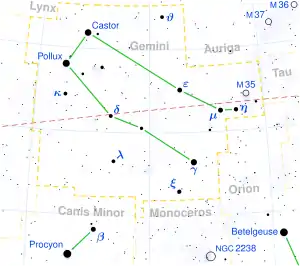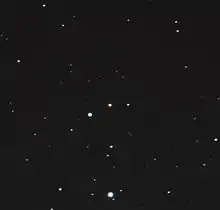U Orionis
U Orionis (abbreviated U Ori) is a Mira-type variable star in the constellation Orion. It is a classical long period variable star that has been well observed for over 120 years.
 | |
| Observation data Epoch J2000.0 Equinox J2000.0 | |
|---|---|
| Constellation | Orion |
| Right ascension | 05h 55m 49.16994s[1] |
| Declination | +20° 10′ 30.6872″[1] |
| Apparent magnitude (V) | 4.8 - 13.0 |
| Characteristics | |
| Spectral type | M8 III |
| B−V color index | +2.07[2] |
| Variable type | Mira |
| Astrometry | |
| Parallax (π) | 2.29 ± 1.21[1] mas |
| Distance | 997.56 ly (306 ± 61[3] pc) |
| Details | |
| Radius | 370 ± 96[4] R☉ |
| Luminosity | 7,000[5] L☉ |
| Temperature | ≈2,750[5] K |
| Other designations | |
| Database references | |
| SIMBAD | data |
Discovery

It was discovered on 1885 December 13 by J.E. Gore and initially it was thought to be a nova in the early stages of decline (Gore's Nova and NOVA Ori 1885 as still listed in SIMBAD), but a spectrum taken at Harvard showed features similar to that of Mira. Thus U Orionis became the first long period variable to be identified by a photograph of its spectrum.[7]
Location
U Orionis lies less than half a degree east of the small-amplitude variable star χ1 Orionis and less than an arc-minute from the much fainter eclipsing variable UW Orionis. χ1 Orionis is slightly brighter than U Orionis at its brightest maximum, while UW Orionis is more than a thousand times fainter, similar to U Orionis at minimum.
Stellar parameters
The star has a low effective temperature (roughly 2700 K) but a large and bloated radius of 370 solar radii[4] and a high luminosity, 7,000 times higher than the Sun.[5] If the Sun were replaced with U Orionis, its radius would extend beyond Mars's orbital zone (about 1.7 astronomical units), and, to be habitable with water at liquid state and a comfortable temperature, a planet would have to be located within 85 AU, within the Kuiper belt's orbital zone.
Possible planetary system
According to Rudnitskij,[8] a 12- to 15-year "super-periodicity" has been observed. The author infers such periodicity could coincide with the revolution period of an invisible companion, probably planetary. So far no clear hint of planetary objects has been detected.
References
- van Leeuwen, F.; et al. (2007). "Validation of the new Hipparcos reduction". Astronomy and Astrophysics. 474 (2): 653–664. arXiv:0708.1752. Bibcode:2007A&A...474..653V. doi:10.1051/0004-6361:20078357. S2CID 18759600.
- Mermilliod, J.-C. (1986). "Compilation of Eggen's UBV data, transformed to UBV (unpublished)". Catalogue of Eggen's UBV Data. Bibcode:1986EgUBV........0M.
- Mondal (2005). "Evidence of asymmetry in Mira variable U Ori". Bulletin of the Astronomical Society of India. 33 (2): 97–102. Bibcode:2005BASI...33...97M.
- Van Belle; et al. (1996). "Angular Size Measurements of 18 Mira Variable Stars at 2.2 microns". Astronomical Journal. 112: 2147. Bibcode:1996AJ....112.2147V. doi:10.1086/118170.
- Mondal & Chandrasekhar (2004). "Evidence of asymmetry in Mira variable U Ori". Monthly Notices of the Royal Astronomical Society. 348 (4): 1332–1336. Bibcode:2004MNRAS.348.1332M. doi:10.1111/j.1365-2966.2004.07454.x.
- "V* U Ori". SIMBAD. Centre de données astronomiques de Strasbourg. Retrieved 25 January 2018.
- Monck (1887). "Mr Gore's Nova Orionis". The Observatory. 10: 69–71. Bibcode:1887Obs....10...69M.
- Rudnitskij (2002). "Molecular Masers in Variable Stars". Publications of the Astronomical Society of Australia. 19 (4): 499–504. Bibcode:2002PASA...19..499R. doi:10.1071/AS02018.